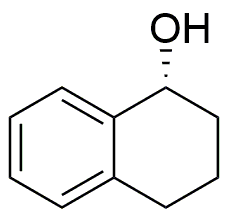(R)-(-)-1,2,3,4-Tetrahydro-1-naphthol is widely utilized in research focused on
- Pharmaceutical Development: This compound serves as a key intermediate in the synthesis of various pharmaceuticals, particularly in the development of analgesics and anti-inflammatory agents.
- Organic Synthesis: It is used in organic chemistry as a building block for creating complex molecules, allowing researchers to explore new chemical reactions and pathways.
- Material Science: The compound is explored in the development of novel materials, such as polymers and coatings, due to its unique structural properties that enhance material performance.
- Biochemical Research: It is utilized in studies investigating the interactions of small molecules with biological systems, helping to elucidate mechanisms of action for various biological processes.
- Flavor and Fragrance Industry: The compound is also investigated for its potential applications in the formulation of flavors and fragrances, providing a unique aromatic profile that can enhance product appeal.
Informations générales
Propriétés
Sécurité et réglementation
Applications
(R)-(-)-1,2,3,4-Tetrahydro-1-naphthol is widely utilized in research focused on
- Pharmaceutical Development: This compound serves as a key intermediate in the synthesis of various pharmaceuticals, particularly in the development of analgesics and anti-inflammatory agents.
- Organic Synthesis: It is used in organic chemistry as a building block for creating complex molecules, allowing researchers to explore new chemical reactions and pathways.
- Material Science: The compound is explored in the development of novel materials, such as polymers and coatings, due to its unique structural properties that enhance material performance.
- Biochemical Research: It is utilized in studies investigating the interactions of small molecules with biological systems, helping to elucidate mechanisms of action for various biological processes.
- Flavor and Fragrance Industry: The compound is also investigated for its potential applications in the formulation of flavors and fragrances, providing a unique aromatic profile that can enhance product appeal.
Documents
Fiches de données de sécurité (FDS)
La FDS fournit des informations de sécurité complètes sur la manipulation, le stockage et l’élimination du produit.
Spécifications du produit (PS)
Le PS fournit une description complète des propriétés du produit, notamment sa composition chimique, son état physique, sa pureté et les exigences de stockage. Il détaille également les plages de qualité acceptables et les applications prévues du produit.
Certificats d'analyse (COA)
Recherchez des certificats d'analyse (COA) en saisissant le numéro de lot du produit. Les numéros de lot et de lot se trouvent sur l'étiquette d'un produit, après les mots « Lot » ou « Lot de fabrication ».
Numéro de catalogue
Numéro de lot/série
Certificats d'origine (COO)
Ce certificat d'exploitation confirme le pays dans lequel le produit a été fabriqué, et détaille également les matériaux et composants utilisés et s'il est issu de sources naturelles, synthétiques ou autres sources spécifiques. Ce certificat peut être requis pour les douanes, le commerce et la conformité réglementaire.
Numéro de catalogue
Numéro de lot/série
Fiches de données de sécurité (FDS)
La FDS fournit des informations de sécurité complètes sur la manipulation, le stockage et l’élimination du produit.
DownloadSpécifications du produit (PS)
Le PS fournit une description complète des propriétés du produit, notamment sa composition chimique, son état physique, sa pureté et les exigences de stockage. Il détaille également les plages de qualité acceptables et les applications prévues du produit.
DownloadCertificats d'analyse (COA)
Recherchez des certificats d'analyse (COA) en saisissant le numéro de lot du produit. Les numéros de lot et de lot se trouvent sur l'étiquette d'un produit, après les mots « Lot » ou « Lot de fabrication ».
Numéro de catalogue
Numéro de lot/série
Certificats d'origine (COO)
Ce certificat d'exploitation confirme le pays dans lequel le produit a été fabriqué, et détaille également les matériaux et composants utilisés et s'il est issu de sources naturelles, synthétiques ou autres sources spécifiques. Ce certificat peut être requis pour les douanes, le commerce et la conformité réglementaire.


